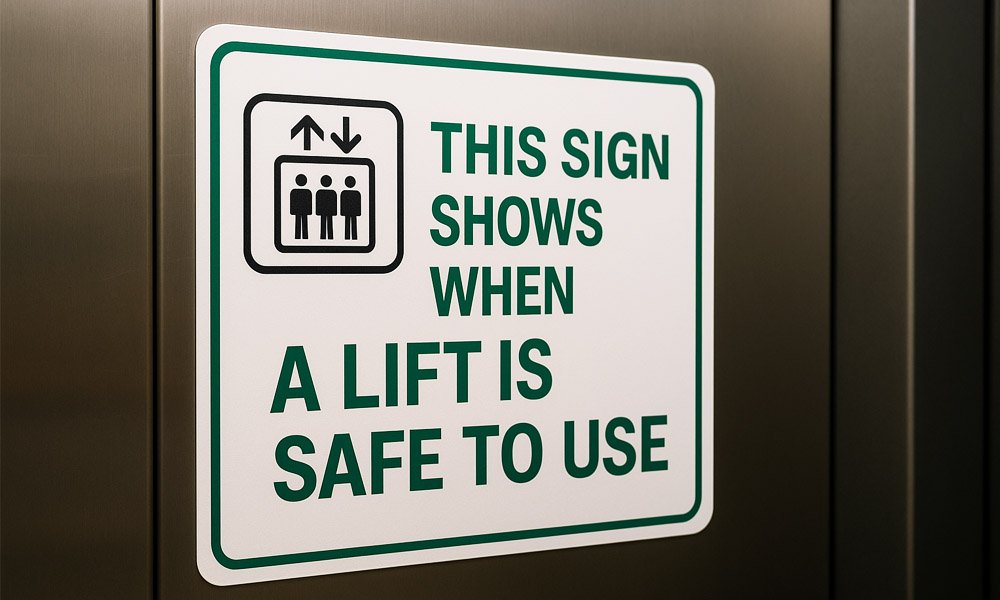Guide
This Sign Shows When a Lift Is Safe to Use
Published
3 months agoon
By
Archie
Have you ever stepped into an elevator and noticed a small sign or certificate hanging on the wall? Most people don’t pay attention to it. You’re probably too busy checking your phone, thinking about work, or just hoping the lift gets to your floor quickly.
But here’s something you may not know: that sign might be the only thing standing between you and a dangerous situation. It’s not just decoration. It’s there to tell you something very important — this lift is safe to use.
In this article, we’re going to talk about what that sign really means. We’ll explain how it works, who puts it there, and why checking it could protect you and your loved ones. Don’t worry — we’ll keep it all simple and easy to understand.
What Is a Lift Safety Sign?
A lift safety sign is like a report card for the elevator. It tells you whether the lift has been checked and passed all safety tests. Think of it like a food safety certificate you see in restaurants, but for elevators.
This sign is usually posted inside the lift cabin or near the doors. It’s often a piece of paper or a sticker, but in modern buildings, it might even be a digital screen or QR code.
Why is it there? To tell you one thing: this lift has been inspected by a trained professional and is safe to use — for now.
What Does the Sign Look Like?
The appearance of the sign can change depending on the country or building, but most signs include:
-
The inspection date
-
The next inspection due
-
The name of the certifying agency
-
A registration or lift ID number
-
Sometimes a phone number to report problems
In high-tech buildings, you might see a QR code instead. You can scan it with your phone to see the lift’s inspection history — kind of like checking the service record of a car before buying it.
So next time you step inside a lift, take a few seconds to glance at that sign. It’s there for you.
Why the Safety Sign Matters So Much
Let’s imagine this: you’re in a tall building, and the elevator takes you up to the 10th floor. You don’t even think twice. But would you still get in if you knew the lift hadn’t been inspected in over a year?
Sadly, many people don’t check. And some buildings forget or ignore safety inspections. That’s where this sign becomes critical. It’s the only quick way for you to know if someone has recently checked that elevator.
Lifts are powerful machines. They move up and down using steel cables, motors, brakes, sensors, and software. If just one thing goes wrong, it could cause a major problem. The safety sign is your proof that everything’s working as it should.
It may look small, but it speaks loudly.
What Happens Before the Sign Goes Up
So, how does the sign even get there? It’s not something the building manager just prints off and tapes inside.
Before the sign is placed, the lift goes through a complete safety check by a certified inspector. This person has special training to test everything inside the lift. They don’t just ride it up and down once — they check all the major parts, like:
-
The brakes
-
The doors
-
The control system
-
The alarm and emergency button
-
The cables and pulleys
-
The floor leveling and stop timing
Only after the lift passes all of these tests does the inspector give the building permission to display the sign. If something fails, the sign does not go up, and the lift must be repaired before it can be used again.
That’s how serious this process is. So when you see the sign, you can feel confident sthat omeone did their job.
Who Is Responsible for Approving the Lift?
Different countries have different rules, but one thing is the same everywhere — only a certified expert can say a lift is safe to use.
In the United States, inspectors follow a rule book called ASME A17.1, which lists all the safety standards. In Europe and the UK, they follow their own strict codes. India uses the Bureau of Indian Standards, and China has its Special Equipment Safety Law.
What does this mean for you? It means that before that sign goes up, your lift has been tested using international safety rules. These aren’t just random checks — they’re carefully planned inspections.
In most places, lifts are inspected every 6 months or once a year, depending on the type of building. Hospitals, malls, and busy places often require even more frequent checks.
What If the Sign Is Missing or Outdated?
You step into an elevator, and there’s no sign on the wall. Or maybe you see a certificate, but the date shows last year. What should you do?
First, don’t panic. But don’t ignore it either.
If the lift safety sign is missing or expired, it could mean the elevator hasn’t been inspected in a long time. That’s a red flag. It doesn’t always mean the lift is unsafe, but it does mean no one has officially checked it recently. And that’s not something to take lightly.
In this case, it’s best to report it to building management right away. You can also contact your local housing authority or elevator safety board if needed. In many cities, it’s actually illegal for a building to operate a lift without a valid safety certificate.
A Real Example: When the Sign Was Gone
Back in 2022, a lift accident happened in a busy office building in the U.S. Three people were injured when the elevator suddenly dropped between floors.
After an investigation, it was revealed that the last inspection was over 14 months overdue. Even worse, the safety sign had been taken down during renovations and never put back up.
The building owners were fined, and city officials began reviewing elevators in other buildings nearby. This event made people realize just how serious lift safety is — and how important that small sign really is.
It’s a powerful reminder: not seeing the sign means you should speak up.
Smart Technology and Modern Lift Safety
Today, many buildings are getting smarter — and so are their lifts.
New elevators often come with smart sensors inside. These sensors check the lift’s condition 24/7. If something starts to go wrong, the system sends an alert to the maintenance team before the problem gets worse.
Some lifts even stop working automatically if a critical error is found. It’s like the elevator saying, “Nope, I’m not safe right now.”
These smart systems are often linked to digital safety signs inside the cabin. Instead of just showing a date, they can display things like:
-
Real-time health of the elevator
-
Weight inside the lift
-
Emergency contacts
-
Digital inspection records
You may also see a QR code on the wall. Just scan it with your phone to view the full inspection history. In 2025, this is becoming more common, especially in modern cities.
How to Stay Safe When Using Any Lift
So, what can you do to stay safe?
Here are a few simple steps anyone can follow:
-
Look for the safety sign every time you enter a lift.
-
Check the date to make sure it’s current.
-
If there’s a QR code, scan it to learn more.
-
If the sign is missing or expired, report it right away.
-
Learn how to use the alarm or emergency button, just in case.
These steps take only a few seconds but can help prevent serious problems.
Think of it like putting on a seatbelt in a car. You hope nothing bad happens, but it’s always better to be safe than sorry.
Lift Safety Signs Are Changing for the Better
The future of lift safety signs is going digital — and that’s a good thing.
Instead of paper stickers that get dusty or fall off, digital panels now offer more useful and live information. Some even show color-coded safety levels — like green for good, yellow for caution, and red for stop.
In some smart buildings, elevators will not move if the sign isn’t updated or something is wrong inside. These features are helping keep people safe in ways that weren’t possible a few years ago.
It’s no longer just about one little paper sign. Now it’s about connected safety that works all the time, not just during inspections.
Bottom-Line
In a world full of busy elevators and tall buildings, we often move fast and trust that everything works as it should. But that simple sign inside the lift? It’s not just decoration. It’s proof that someone has checked, tested, and confirmed that it’s safe to ride.
“This sign shows when a lift is safe to use” — and that’s a message that should never be ignored.
It tells you that safety was taken seriously. That someone did the right thing. And that you can ride without fear.
So next time you walk into a lift, take a second to look for that sign. Because when it comes to safety, even the smallest details can make the biggest difference.
Other Articles You May Read:
You may like

How to Make Paying Taxes Easier

Top Ikea Hacks to Transform Your Home Efficiently

Unique Ways to Immerse Yourself in Local Culture While Travelling

Importance of Three Ashras of Ramadan in Islam

How Local Couriers Support Small Businesses

Best Replica YSL Bag in Patent Leather

Put Pen to Paper: How Custom Notebooks Can Make a Lasting Impression

From Listing to Sold: Sell A Car in Perth Without the Stress

Unlocking the Benefits of Engineered Steel Solutions for Modern Construction

Discover the Ultimate Comfort and Style of Women’s Underwear in Australia

Carol Kirkwood’s Journey: Her Real Age, Husband, Career, and More

Revolutionizing Healthcare: The Emergence of AI-Driven Analytics

How Machine Learning and AI are Redefining the Future?

Aliza Barber: Meet Lance Barber’s Wife, Age, Life, Profile, Career and Net Worth

Evelyn Melendez: Jordan Knight’s Wife Bio, Marriage, Family, Career and Net Worth

Ilan Tobianah Biography: Family, Marriage, Lifestyle, Career and Net Worth

Who was Alice Marrow? Everything to Know About Ice-T’s and His Mother

King Von’s Autopsy Report: The Truth Behind the Tragic Death

Meet Otelia Cox: The Supportive Wife of Tony Cox – A True Fairy Tale Romance

Tea Leoni and Tim Daly Split – A Closer Look at Their Relationship and Breakup

How to Make Paying Taxes Easier

Top Ikea Hacks to Transform Your Home Efficiently

Unique Ways to Immerse Yourself in Local Culture While Travelling

Importance of Three Ashras of Ramadan in Islam

How Local Couriers Support Small Businesses

Best Replica YSL Bag in Patent Leather

Put Pen to Paper: How Custom Notebooks Can Make a Lasting Impression

From Listing to Sold: Sell A Car in Perth Without the Stress

Unlocking the Benefits of Engineered Steel Solutions for Modern Construction

Discover the Ultimate Comfort and Style of Women’s Underwear in Australia
Category
Trending
-

 News2 months ago
News2 months agoCarol Kirkwood’s Journey: Her Real Age, Husband, Career, and More
-

 Health2 years ago
Health2 years agoRevolutionizing Healthcare: The Emergence of AI-Driven Analytics
-

 Technology2 years ago
Technology2 years agoHow Machine Learning and AI are Redefining the Future?
-

 Celebrity1 year ago
Celebrity1 year agoAliza Barber: Meet Lance Barber’s Wife, Age, Life, Profile, Career and Net Worth
